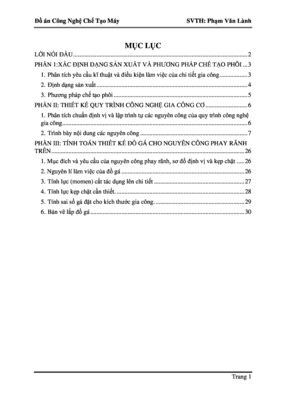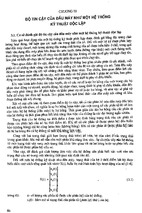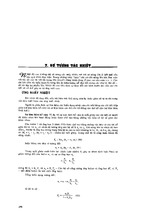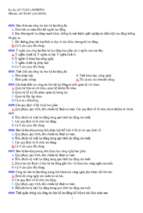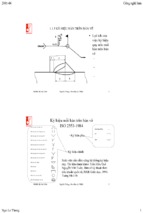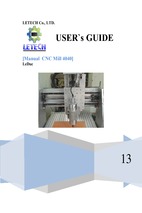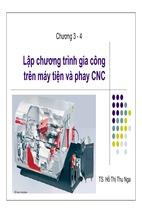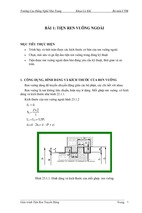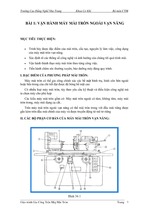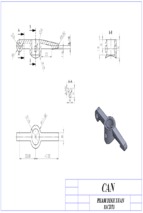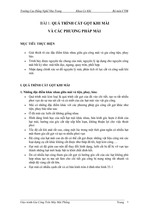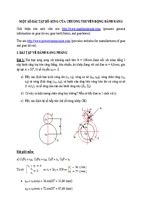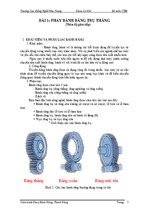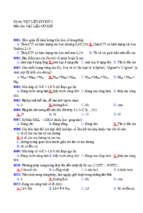Mô tả:
Generative Assembly Structural Analysis
CATIA V5 Training
Foils
Copyright DASSAULT SYSTEMES
Generative
Assembly Structural
Analysis
Copyright DASSAULT SYSTEMES
Version 5 Release 19
September 2008
EDU_CAT_EN_GAS_FF_V5R19
Student Notes:
Generative Assembly Structural Analysis
About this course
Student Notes:
Objectives of the course
Upon completion of this course you will be able to:
- Understand what types of hypotheses are used for an assembly analysis
- Define analysis connections between assembly components
- Use existing assembly constraints to automatically create connections
- Assign a connection property to the appropriate analysis connection
- Compute a static analysis for an assembly
- Create and manage an analysis assembly model from existing meshed
parts
Targeted audience
Mechanical Designers
Copyright DASSAULT SYSTEMES
Prerequisites
Students attending this course should have knowledge of CATIA V5
Fundamentals, Generative Part Structural Analysis Fundamentals
Copyright DASSAULT SYSTEMES
1 Day
Generative Assembly Structural Analysis
Student Notes:
Table of Contents (1/2)
Introduction to GAS
What is Generative Assembly Structural Analysis
Assembly Analysis Overview
Analysis Assembly Overview
what is GAS
Hypotheses Used for Analysis
To sum Up
Analysis Connections
What is Analysis Connection
General Analysis Connection
Defining Line Analysis Connections
Defining Point Analysis Connections
Defining Surface Analysis Connections
Points to Points Analysis Connection
Set of Analysis Connections
To Sum Up
Copyright DASSAULT SYSTEMES
GAS Connection Properties
Face Face Connection Properties
Copyright DASSAULT SYSTEMES
5
6
8
9
10
11
12
13
14
20
24
31
37
44
47
51
52
53
Generative Assembly Structural Analysis
Student Notes:
Table of Contents (2/2)
Distant Connection Properties
Welding Connection Properties
Nodes to Nodes Connection Property
To Sum Up
Analysis Assembly Management
Copyright DASSAULT SYSTEMES
What is Analysis Assembly
Why Use Analysis Assembly
Analysis Assembly Process
What is Shape Representation
How to Attach Shape to Part
How to Attach Analysis Document in Product Tree
How to Attach Orphan Mesh Analysis Document
What is Analysis Assembly 2D Viewer
How to Use Analysis Assembly 2D Viewer
To Sum Up
Copyright DASSAULT SYSTEMES
73
90
97
100
101
102
103
104
105
106
108
110
112
113
114
Generative Assembly Structural Analysis
Introduction to GAS
Copyright DASSAULT SYSTEMES
You will learn the rules necessary to a good understanding and use of GAS
Copyright DASSAULT SYSTEMES
Student Notes:
Generative Assembly Structural Analysis
What is Generative Assembly Structural Analysis (1/2)
Generative Assembly Structural Analysis (GAS) is a tool to perform structural analysis
of assemblies. It provides features to model physical assemblies into Finite Element
Assemblies.
While designing, structural analysis of individual parts is performed. These parts are
commonly components of a product.
For example, analysis of crank shaft helps to
understand structural, dynamic behavior under
applied load, and to improve the design.
Crank shaft
Copyright DASSAULT SYSTEMES
Crank shaft is one part of engine
assembly which also contains
connecting rod, pin, piston, bolts etc.
Once these individual parts are assembled, it is
necessary to understand structural and
dynamic behavior of assembly. Therefore,
assembly analysis is required.
Copyright DASSAULT SYSTEMES
Crank shaft in engine assembly
Student Notes:
Generative Assembly Structural Analysis
What is Generative Assembly Structural Analysis (2/2)
We have two basic approaches to perform Generative Assembly Structural analysis.
Assembly Analysis:
Analysis Assembly:
Product
Product
Part 1
Part 2
Part 3
Part 1
Analysis 1
Part 2
Analysis 2
Analysis 3
Analysis
Orphan Mesh Analysis
The Analysis available in
parts is reused to create
the Global Analysis.
You can directly attach
analysis in product tree.
You can attach orphan
mesh analysis.
Copyright DASSAULT SYSTEMES
Global Analysis
In this approach you
create the assembly
and analyze it.
Copyright DASSAULT SYSTEMES
In this approach, analyses of individual
parts in product are available. This
analyses are assembled to form ‘Analysis
Assembly’ and then final analysis called
‘Global analysis’ is performed.
Student Notes:
Generative Assembly Structural Analysis
Student Notes:
Assembly Analysis Overview
1
Copyright DASSAULT SYSTEMES
2
3
Perform analysis and
view results
Copyright DASSAULT SYSTEMES
Assign Finite Element
properties to parts in
assembly
Assign connection
and connection
properties
Generative Assembly Structural Analysis
Student Notes:
Analysis Assembly Overview
1
Attach shapes to
parts in product
2
Assign connection
properties
Copyright DASSAULT SYSTEMES
3
Apply loads
and constraints
4
Perform global analysis
and view results
Copyright DASSAULT SYSTEMES
Generative Assembly Structural Analysis
What is GAS
The GAS license provides functionalities for analysis of assembly, through the GPS
workbench. It allows you to define connections between assembly components and
assign different types of connection properties to these connections to simulate the real
connection behavior.
In other words, ‘GAS’ allows you to define real constraints besides assembly constraints
using connection properties. It lets you define four different kinds of connection properties:
Face/Face Connection properties
Distant Connection properties
Welding Connection properties
Copyright DASSAULT SYSTEMES
Point Based Connection Properties
However, you must have previously defined ‘Assembly constraints’ or ‘Analysis Connections’ using
GAS Workbench to be able to create the connection properties between the parts of assemblies. By
the way, you must make sure that your assembly is not over-constraint.
You may also need to add assembly constraints at a given distance (this constraint goes through a
virtual point) so that you can simulate a part that is not designed.
Copyright DASSAULT SYSTEMES
Student Notes:
Generative Assembly Structural Analysis
Hypotheses Used for Analysis
When you work with the Analysis workbench, three types of hypotheses are made:
Small displacements (translation and rotation)
Small strain
Linear constitutive law: linear elasticity
Thus, If there is no contact feature (either virtual or real), no pressure fitting property and no bolt
tightening (being virtual or not) feature, then the problem is linear, which means that the displacement
is a linear function of the load.
Copyright DASSAULT SYSTEMES
On the other hand, If there is at least one contact feature (either virtual or real) or pressure fitting
property or bolt tightening (being virtual or not) feature, then the problem is non linear, which means
that the displacement is a non linear function of the load.
Copyright DASSAULT SYSTEMES
Student Notes:
Generative Assembly Structural Analysis
To Sum Up ...
You have learned following things about GAS
Copyright DASSAULT SYSTEMES
What is Generative Structural Assembly Analysis
Generative Structural Assembly Analysis approaches
Hypothesis used for Analysis
Copyright DASSAULT SYSTEMES
Student Notes:
Generative Assembly Structural Analysis
Analysis Connections
In this lesson, you will see what are the different types of GAS Analysis
Connections, necessary to define support for Analysis Connection properties.
Copyright DASSAULT SYSTEMES
What is Analysis Connection
General Analysis Connection
Defining Line Analysis Connections
Defining Point Analysis Connections
Defining Surface Analysis Connections
Points to Points Analysis Connection
Set of Analysis Connections
To Sum Up
Copyright DASSAULT SYSTEMES
Student Notes:
Generative Assembly Structural Analysis
Analysis Connection
Copyright DASSAULT SYSTEMES
You will learn what is Analysis Connection and why it is required.
Copyright DASSAULT SYSTEMES
Student Notes:
Generative Assembly Structural Analysis
Why Use Connections and Connection Properties
GAS has made conversion of physical assemblies to FE assemblies very easy by
means of connection and their connection properties. Wide variety of connection
types and connection properties are provided to model physical assembly
connections.
When parts are connected to each other, they transmit rotational
and translational DOFs in a well defined manner. In addition to this,
connection itself has structural properties which need to be taken
into account.
Copyright DASSAULT SYSTEMES
For example, when two parts are connected through spring joint, the spring
stiffness will also play a role. This stiffness will dictate the amount of
displacement transferred from one part to another. This can also be viewed
for welded or bolted assemblies.
Connection defines which parts in assembly are connected and
connection property assigns related physical properties to those
connections. You can also effectively utilize the constraints defined
in assembly as support in connection properties.
Copyright DASSAULT SYSTEMES
Student Notes:
Generative Assembly Structural Analysis
Using Assembly Constraints for Analysis Connections
You can use either following assembly constraints or corresponding analysis connection as
support for creating connection property. Thus, if Assembly constraints are already defined
then there is no need to create analysis connection as a support for creating connection
property.
Copyright DASSAULT SYSTEMES
You need to create analysis connection if assembly constraint is not available for required
joint. You will see which are the most appropriate constraints for each kind of connection.
Coincidence constraint
General Analysis Connection
Contact constraint
Line Analysis Connection
Offset constraint
Point Analysis Connection
Fix constraint
Surface Analysis Connection
The following matrices show you, with respect to the connection type, what constraints are
necessary for their creation. You will notice that, some connections (like rigid or smooth) can be
applied on different kinds of constraints while others can be applied on a specific constraint only.
Copyright DASSAULT SYSTEMES
Student Notes:
Generative Assembly Structural Analysis
What Assembly Constraint to Use for What Connection
You will see which are the most appropriate constraints for each kind of connection.
Connections
Point / Point Point / Line Point / Face Line / Line Line / Face Face / Face
Slider
Contact
Fastened
Fastened Spring
Pressure Fitting
Bolt Tightening
Copyright DASSAULT SYSTEMES
Rigid
Smooth
Virtual Rigid Bolt
Tightening
Virtual Spring
Bolt Tightening
User-Defined
* with optional handler point
Copyright DASSAULT SYSTEMES
Contact
Contact
Coincidence
Contact
Coincidence
Contact
Coincidence
Contact
Coincidence
Contact
Coincidence
Contact
Coincidence
Contact
Coincidence
Contact
Coincidence
Contact
Coincidence
Contact
Coincidence
Contact
Coincidence
Contact
Coincidence
Contact
Coincidence
Contact
Coincidence
Contact
Coincidence
Contact
Coincidence
Contact
Coincidence
Contact
Coincidence
Contact
Contact
Contact *
Contact *
Contact *
Contact
Contact
Contact *
Contact *
Contact *
Contact
Coincidence
Contact
Coincidence
Contact
Contact
Coincidence Coincidence
Contact
Coincidence
Contact
Coincidence
Contact
Coincidence
Contact
Contact
Coincidence Coincidence
Contact
Coincidence
Offset
Offset
Offset
Offset
Offset
Contact
Contact
Contact
Contact
Contact
Student Notes:
Generative Assembly Structural Analysis
How to Use Assembly Constraints in Connection
Property
You can use appropriate assembly constraints as support in
connection property. It is not necessary to create Analysis
Connection if corresponding Assembly constraint is available.
1
Select Surface contact
constraint as in supports
Copyright DASSAULT SYSTEMES
2
Copyright DASSAULT SYSTEMES
Click on Smooth
Connection Property
Student Notes:
Generative Assembly Structural Analysis
Student Notes:
Common Tools
All “seam” connections (Point, Line, Surface connections) can be applied directly on
mesh parts
The “Mesh part filter” tool is available
for all analysis connections
Copyright DASSAULT SYSTEMES
Reminder: when a geometrical support
is selected, it allows you to choose
between all associated mesh parts
It enables connection definition for orphan meshes (imported meshes)
Copyright DASSAULT SYSTEMES
Generative Assembly Structural Analysis
General Analysis Connection
Copyright DASSAULT SYSTEMES
You will learn how to define a General Analysis Connection and when to use it
Copyright DASSAULT SYSTEMES
Student Notes:
- Xem thêm -


